

“Movement of the First”: How Ukrainian Children in the Occupied Territories are Taught to be Russians
The Soviet Union failed to fulfil the goal it declared as achieved – to create a monolithic community called “Soviet people.” Many factors prevented this, including the vast differences between the Soviet republics, the peculiarities of national cultures, and differences in traditions. There were some successes in Russification, but it all led to the collapse of the Soviet Union.
Today, Russia is once again trying to erase ethnic peculiarities and create a single “Russian people.” Among the tools used is the reduction of the network of educational institutions with national languages of instruction, creation of social lifts for those willing to work for the idea of the “united great Russia,” and the establishment of horizontal links between the subjects of the federation and erasure of regional differences.
The Russian state is using carrots and sticks to involve children first of all, including those from the occupied territories of Ukraine, in these processes.
Activists go to the sea
Every schoolchild would like to go to a sea camp for three weeks, even if it is in March. Especially instead of school. Especially when they don’t have to pay for the trip. Schoolchildren from the “new subject of the Russian Federation,” the Luhansk “republic,” took part in the competition and were looking forward to the results. They had been looking at the Movement of the First page on VKontakte since January.
And now, the long-awaited moment. On 1 February, an announcement was posted on the page listing the winners of the competition. Seven candidates were selected from the occupied part of the Luhansk region, seven schoolchildren from the Republic of Dagestan and eight from the Samara region and Stavropol each. A total of 30 children.
In February and March, three of the ten camps of the All-Russian Children’s Centre “Eaglet” operate. This time, the “Standout of the First” themed programme was hosted by the “Whirlwind” camp.
“…schoolchildren generate ideas, putting forward initiatives in one of the most important areas of the Movement of the First activities: the generation of ideas is based on events related to the preservation of Russian historical heritage, development of patriotism, love, and respect for the Motherland,” the website of the Eaglet children’s centre described the objectives of this programme.
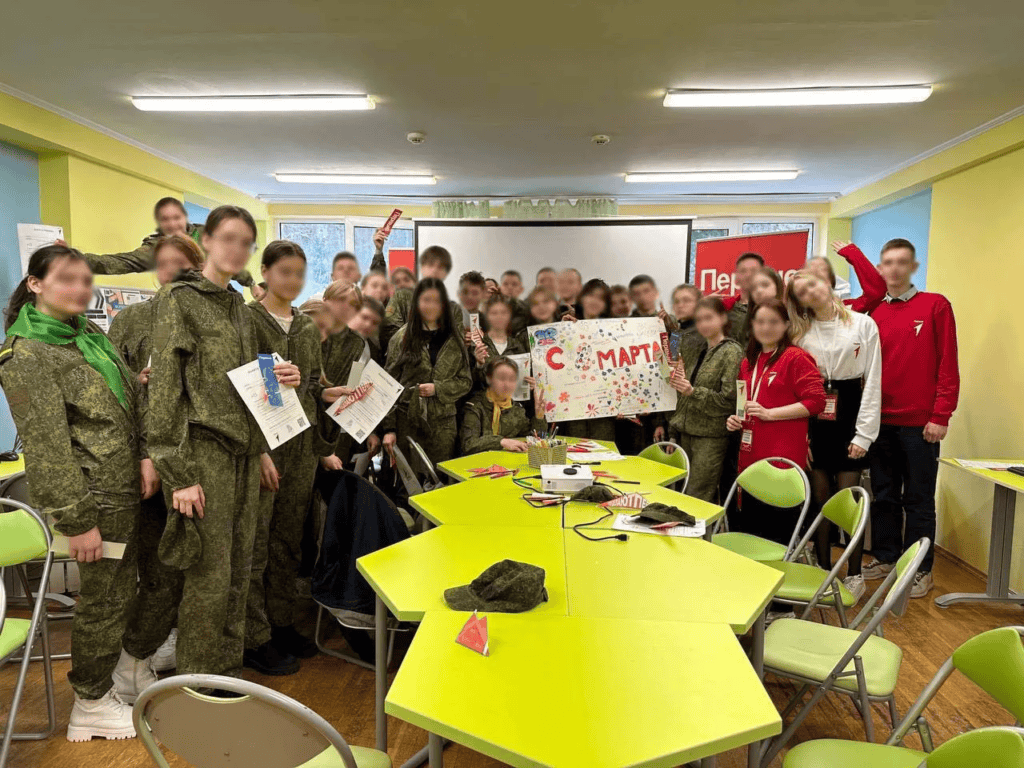
Celebrations of the 8 March were prepared in camouflage. Photo: VK/Shifts of the Movement of the First
The children manage to do a lot during the three weeks of the shift. There are excursions, workshops, and games aimed at developing flexible thinking and communication skills. The children also have time to wear camouflage and improve their media talents under the guidance of the Kuban 24 TV channel team. This is the Krasnodar branch of the Russian state TV channel Rossiya 24.
In the end, the teenagers made so-called maps of the Movement’s primary branch in their region. This task was set with a view to building the organisation’s network. Of course, this trip to the camp was not a holiday at all. It was staff training. And it is clear that having gained new knowledge and skills, the teenagers will make efforts to build a network where they will no longer be at a lower level, but in leadership.
The Firsts’ shifts are continuing, with more and more children attending the children’s centre, and the outreach is increasing. For example, in June, there was a shift with the participation of teenagers from the occupied part of the Donetsk region, Kabardino-Balkaria, Mari El, Chuvashia and the Lipetsk region.
To practise their campaigning skills, they introduced the Movement of the First to other children in the camp. In addition to explicitly propagandistic programmes such as the Commonwealth of Eaglets or the School of Creative Diplomacy, the children’s centre also hosted ostensibly apolitical events: The Forum of School Theatres, Oceanautics, Dancing Eaglet, etc. It was at these events that the “Standout of the First” primarily honed their skills.
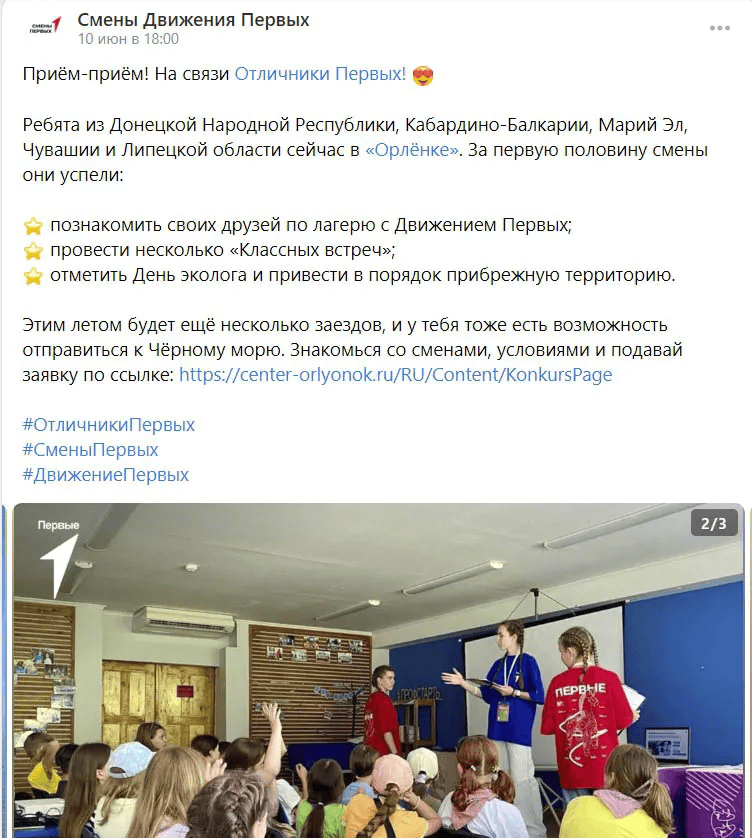
“Standout of the First” students honed their skills on participants of other programmes who were at the Eaglet children’s centre at the same time. Screenshot
How they get there. “We are part of a big country”
To get into a shift, they had to fill out a questionnaire (preferably with awards or recommendations from the Movement of the First at the central or local level) and solve three cases. Each of the cases represented a real-life situation in which they had to think creatively about how to develop their school-based Movement of the First organisation. In Movement of the First, those who are already motivated and inclined to work with children’s groups are trained.
In 2024, children from all the “new regions of the Russian Federation” – the occupied territories of the Luhansk, Donetsk, Kherson, and Zaporizhzhia regions – will attend the shifts. But each of these regions will visit the Eaglet not with other “new” regions, but with the “old” regions of Russia.
This is about establishing horizontal ties and fitting children from the occupied territories into the all-Russian context, integrating them into the “big country.” We have already seen how the Donetsk “republic” was inscribed among Kabardino-Balkaria, Mari El, Chuvashia and the Lipetsk region.
The regulations on the competition for “training in the thematic additional general development programme ‘Standout of the First’” (as it is officially called) for each shift also assign members of the commissions. They are also mixed for each region.
For example, the selection from the Luhansk “republic” was headed by the chief of the Luhansk regional branch of the Movement of the First Ruyal Asif oglu Aliyev with representatives from Stavropol and Dagestan. Two representatives of the “Luhansk city district” processed applications from the Samara region and the Republic of Dagestan. The leadership of regional movements is mixed in the same way as teenagers – for the sake of the same horizontal connections of the future elite of the “united people of Russia.”
This is an example of just one curriculum. Alongside this shift, the Eaglet children’s and youth centre is implementing other programmes, such as the Media Squad (children are taught to be propagandists for the “Russian world”), Keepers of Historical Memory (supporting the official version of Russian history), Drone Academy (teaching children to be drone operators), Great Pushkin’s Journey, Love for the Fatherland, and so on. From 31 May to 20 June, the camp hosted the Summer Youth Army Games shift.
The Eaglet in the Krasnodar region has become one of the centres for spreading propaganda among children, and not only through the Movement of the First. And not only through schoolchildren. For example, at the end of 2023, “advisers to directors for education and interaction with children’s civic associations of professional educational organisations” – colleges – were sent there for training. Realna Gazeta has a letter from the “ministry of education and science” of the Luhansk “republic” with a list of a delegation of 60 school officials.
Similar work is going on in all large camps of Russia. In addition to the Eaglet, other camps are involved. From the Artek Children’s and Youth Centre in the occupied Crimea and the Shift Children’s and Youth Centre in the Krasnodar region to the Ocean Children’s and Youth Centre in the Far East. This work involves thousands of adult educators and tens of thousands of children and teenagers.
Actors in Luhansk
The Luhansk organisation of the Movement of the First is headed by Ruyal Aliyev. Despite his Azerbaijani name and the fact that he lists Krasnodar as his hometown on Vkontakte, he graduated from school in 2014 in Valuyske near Stanytsia Luhanska. He entered a “university” under occupation – a clone of the Luhansk State Academy of Culture and Arts named after Matusovsky – to study film directing.
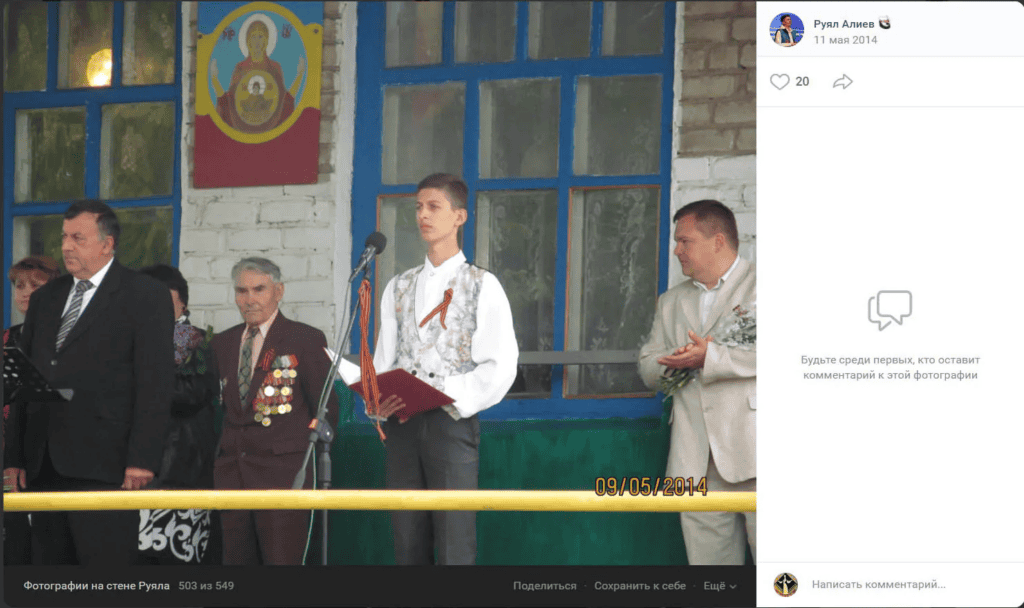
Ruyal Aliyev with the St. George’s ribbon, which then became a symbol of the “Russian spring,” during the Victory Day celebrations in 2014. Screenshot
During his studies, he was active, ran for “students’ president,” and his photo on Instagram “liked” Yelena Zaslavskaya, a poet and propagandist of the “Russian world” who is the editor of the “university” newspaper Kamerton.
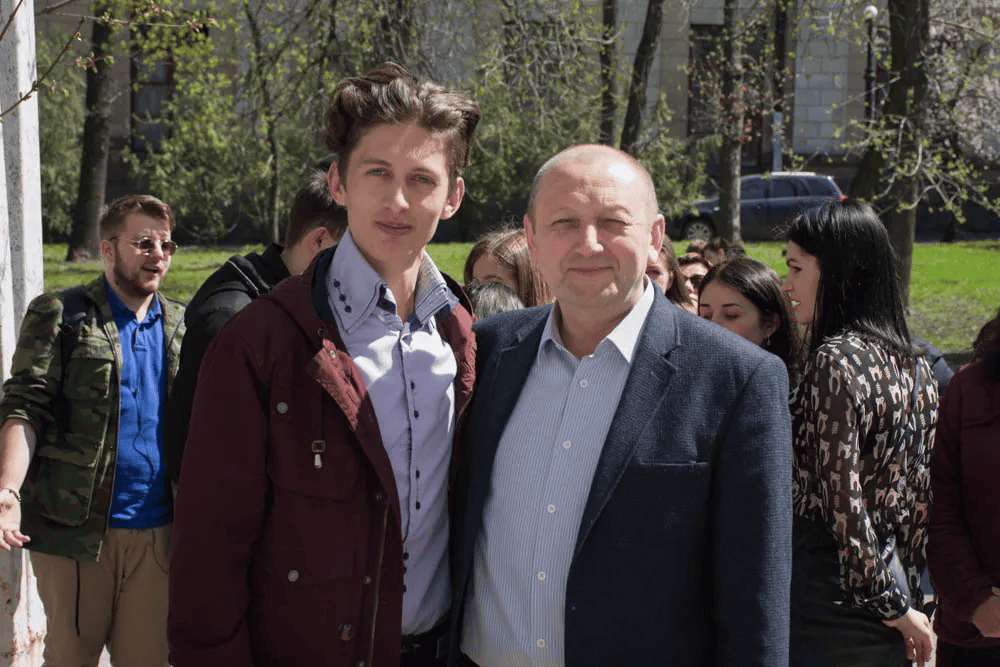
Ruyal Aliyev (left) together with the rector of the Academy of Culture and Arts under occupation, a member of the “people’s council” of the Luhansk “republic” Valery Filippov. Photo: VK/ruyal_special_one
After graduation, he worked as a host in celebrations (weddings, corporate events, graduations, etc.) and was also an art director of the Panorama karaoke restaurant (Luhansk residents remember it as Alkuba, across the street from Proliska on Sovetska Street). Later, he also joined the work of the “first youth TV channel of the republic” TIM (from the Russian Television Initiative of Youth).
The format of the channel is declared as “a la TNT” – entertaining content, “and most importantly – without politics and military” (according to the head of the so-called “non-governmental organisation Media Group ‘Television Initiative of Youth’” Yevhen Muriliov). Ruyal Aliyev got his own talk show, Ruyaliti Show. The episodes were posted on YouTube, but the channel has been deleted. However, the announcements have been preserved on Ruyal’s Instagram page.
These were the stepping stones to a real career rise – the position of head of the regional branch of the Movement of the First, established in February 2023. Interestingly, shortly after graduating from the “university,” Aliyev got married, became a father, and actively positioned himself as a conscious father who adheres to “traditional values.” It is not surprising that in April 2024, he also became a co-founder of the regional branch of the “All-Russian civic movement” Fathers of Russia. However, his activities are focused on the work in the Movement of the First.
Where did the Movement of the First come from?
The general public in Ukraine knows little about the Movement of the First. It is mostly seen as a futile attempt by the Kremlin to galvanise the corpse of Soviet Pioneers. Such attempts have already been made (for example, the Russian Schoolchildren’s Movement, created in 2015), but they have not resulted in anything that actually works. The Youth Army, created in 2016, for a long time, was also not massive and effective enough in working with children and young people.
But the Movement of the First is different. To begin with, by personal order of the Russian dictator Putin, more than 21.3 billion rubles are allocated to this organisation every year. This is comparable to the annual budget of a small Russian region.
The organisation was created in 2022 “on a grassroots initiative.” Of course, it was orchestrated. The proposal was made at Putin’s meeting with schoolchildren participating in the all-Russian project Big School Break (video is blocked in Ukraine but available via VPN). A carefully selected girl, Diana Krasovska, was entrusted with proposing. At the time, she was studying in the 7th grade in occupied Sevastopol, but she was born and spent the first years of her life in Ukrainian Luhansk.
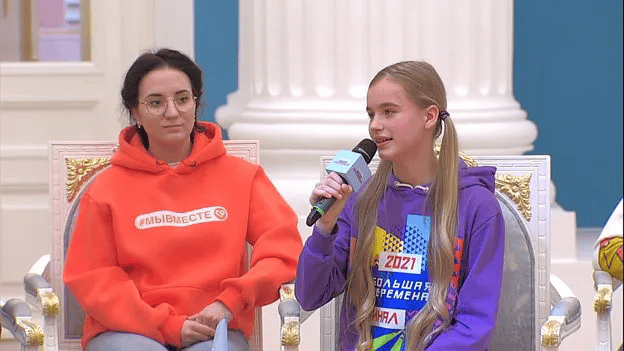
Diana Krasovska, a schoolgirl from Sevastopol, originally from Luhansk, suggested that Putin create a “new Pioneers.” Photo: “Russia – Land of Opportunity”
A month later, a group of State Duma deputies submitted a draft law on the Russian Movement of Children and Youth Big School Break. The submission took place on the day of the 100th anniversary of the All-Union Pioneer Organisation named after Lenin, 19 May. The name disappeared in the passed law, and it was only defined in December when the organisation’s first congress took place, and it was called the Movement of the First.
Before that, however, Putin signed the law passed by the State Duma and “agreed” to head the organisation’s supervisory board. Almost 40 different youth and children’s organisations took part in the constituent assembly to create the movement in the Artek children camp in occupied Crimea. Among them, the largest are the aforementioned Russian Schoolchildren’s Movement and Youth Army.
The Movement of the First is not a civic organisation. The “genre” of this entity is defined by a strange wording – “All-Russian civic and state movement of children and youth”.
The coverage is massive. How an all-Russian network of ideological indoctrination is being built
In practice, the definition of a “civic and state movement” means that in each subject of the federation, including the “new territories” – the occupied districts of the Luhansk, Donetsk, Kherson, Zaporizhzhia regions and the Autonomous Republic of Crimea, – local administrations are responsible for the development of the Movement of the First.
Namely, the regional ministries of education. They are involved in the creation of primary branches of the organisation. Do you remember the training of “advisers to directors on education” from the Luhansk “republic” at the Eaglet children’s centre? These are the very people who are implementing the work on the ground. For example, not only the head of the regional organisation, Ruyal Aliyev, but also the “minister of education” of the Luhansk “republic” Ivan Kusov attended the opening of the first branch of the Movement of the First in Rovenky.
The “civic and state” nature of this all-Russian association also means centralised funding, as we have already mentioned, and management. In September 2022, after signing the law on the creation of the movement, Putin ordered not only to finance the organisation. He instructed his administration to create an official position of chairman of the movement’s board, providing for “social, medical and other services” for this person.
And on the eve of the first congress of this “Russian movement of children and youth” in December 2022, Putin personally signed a decree appointing Grigory Gurov, a former Rosmolodezh (Russian state agency for youth affairs) official and at the time deputy minister of education of Russia, as the chairman of the board.
As of the beginning of 2024, according to Grigory Gurov, chairman of the board of the Movement of the First, the organisation had 4.7 million members, including 630,000 mentors. Earlier in the interview, he said that they would consider full-time employment for such mentors or, possibly, part-time work in educational institutions. There were more than 42,000 primary branches – not only in schools but also in colleges, universities, youth centres, etc.
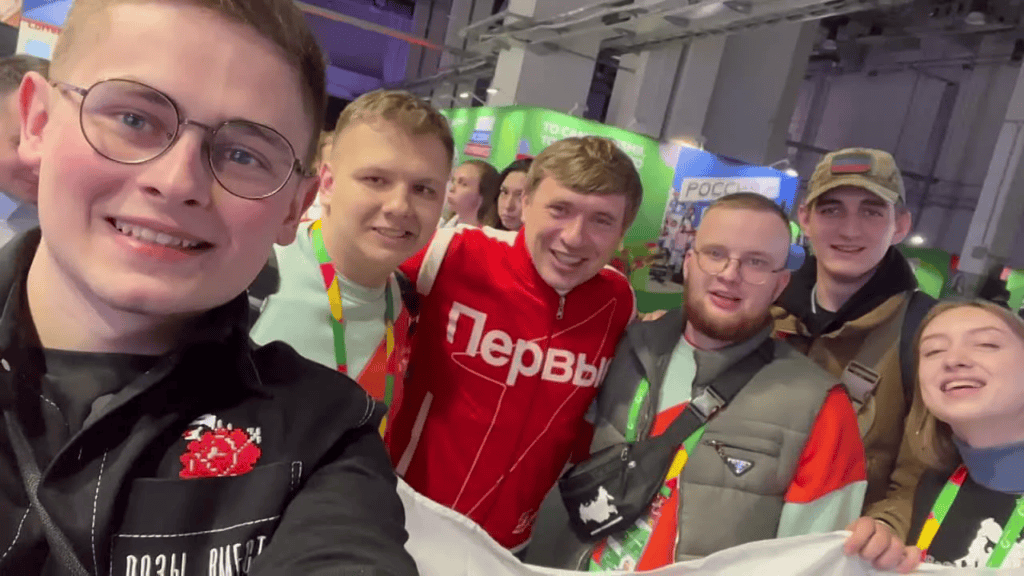
Grigory Gurov (centre), chairman of the board of the Movement of the First, pays special attention to working with the “new regions.” In the photo, he is with a delegation from the occupied part of the Donetsk region at the World Youth Festival in Sochi in March 2024. Screenshot
The Movement of the First signed an agreement with the Moscow State Institute of International Relations during the World Youth Festival in Sochi this year. Its assistance is expected in establishing international relations. However, the Movement of the First is already establishing them and intends to export its approaches to engaging young people in initiatives needed by authorities. It is about contacts with the BRICS countries and Iran, and in general, they are developing ties with almost 30 countries. These are the countries of the Global South, where Russia is trying to increase its influence.
A new Pioneers movement is being built under the leadership of the Russian presidential administration
The creators of the Movement of the First deny any affinity with the Soviet Pioneers movement, but de facto this organisation has to fulfil the same role: to educate children in the spirit required by the Kremlin, to present them with patriotism and readiness to fight for Russian interests as real values and life guidelines. Organisationally, the Movement of the First is also similar to the Pioneers movement: branches in all educational institutions, paid Pioneers’ leaders (now called “mentors”), etc.
This organisation is part of the sphere of influence of the deputy head of the Russian presidential administration, the “technocrat” Sergei Kiriyenko. He supervises almost a dozen all-Russian ideological networks in the public sphere alone, from the Russian Military History Society and the Knowledge Society to the Movement of the First.
At the same time, Kiriyenko is in charge of relations with formally non-governmental organisations that are funded by the Russian state budget and shape the regional agenda. These include, for example, the Autonomous Non-Governmental Organisation Dialogue Regions and its Regional Management Centres and the Russia – Land of Opportunity organisation. It was the latter that implemented the Big School-Break project, at a meeting of which Putin was invited to create a “new Pioneers.”
Kiriyenko is also a frequent visitor to the “new regions,” particularly to Luhansk, where he pays great attention to propaganda activities, from communication with young people to monumental propaganda. For example, it was on his initiative that the Sharp Barrow Memorial Complex was reconstructed. The complex, which was built in memory of the Red Army soldiers of the Civil War and World War II, is now dedicated to “four generations of heroes”: the Civil War, the Great Patriotic War, “militia of the Russian Spring” of 2014, and “heroes of the Special Military Operation.”
Mind control begins from childhood
The Movement of the First is a powerful tool that instils love for Russia as a core value in the minds of schoolchildren. But at the same time, this movement is only a supplement to the existing arsenal of educational propaganda. Children in the occupied territories are presented with Russia as their “homeland.”
“My grandson graduated from the first grade this year. Before that, my husband and I talked to him about Ukraine and read Ukrainian fairy tales. And then he saw my yellow and blue jewellery and said: “Grandma, Ukraine is the enemy! They attacked us!” I was confused. A year at school changed everything,” says Oksana (name changed), a Luhansk resident.
In the “old” occupied territories (which have been under the control of the occupiers since 2014), those studying today in grade school were born after the beginning of the Russian occupation, so most of them have never had a Ukrainian identity. High school and university students have spent most of their lives under the pressure of propaganda, and they also do not perceive themselves as Ukrainians.
In the “new” occupied territories seized after February 2022, schoolchildren had time to realise that they are citizens of Ukraine, so it is more difficult for Russian propaganda to reach them. But wherever “Russian educational standards” are being introduced, propaganda goes hand in hand. Children who were taken away from the occupied territories and Russia tell how they were “re-educated.”
“We have children who say that they were forced (to perceive Russia as a new homeland. – RG),” says Daria Kasianova, head of the Ukrainian Network for the Rights of a Child. “There were cases when they were in camps when they were taken to Crimea, for example, or to Russia. There they worked on this with the children. These are children who remained in the occupied territories. And what happened in schools? Various representatives came to the schools and told them about “Great Russia.” That they should be proud to join and help.”
It is no wonder that among the first eight Russian officials in the “ministries” of the Luhansk “republic,” half were involved in youth work. Those were the “minister of education” Ivan Kusov, his two deputies Yevgeny Miroshnichenko and Pyotr Ishkov, and the “deputy minister of culture, sports and youth” Vasilyi Noskov.
Russian practices include, for example, the daily solemn raising of the tricolour in front of schools accompanied with the sound of the anthems of Russia and the Luhansk “republic”. In Russia and the occupied territories, extracurricular classes called “Conversations about Important Things” were introduced. Every school week begins with these classes, and topics for all classes are the same each week, except for age-specific features. The topics include Russian state symbols, “loyalty to the fatherland,” “Russian Federation peoples’ friendship,” and “traditional values.” Parents of children who ignore these lessons are threatened with amenability. History teaching occupies an important place in Russian education, not only Russian history but also local history, where nothing Ukrainian is now included.
Russia is introducing a new educational platform called Spherum, which requires mandatory registration on the Vkontakte social network, which is fully controlled by the Russian government and special services. All students, their parents and teachers must register on this platform. Parallel registration on Vkontakte and Sferum eliminates anonymity online and puts users under additional scrutiny. Thus, any manifestation of disloyalty to the Russian Federation will be immediately linked to the “guilty” person.
Also, “ministries of education” in the occupied territories demand that all online communication between teachers and parents and children be transferred to Sferum, leaving third-party platforms such as Viber, WhatsApp and Telegram behind.
It is also worth mentioning the demands of the Luhansk “ministry of education” to teachers to control the content of students’ smartphones, namely to monitor which Telegram channels they are subscribed to, which communities they read on social media, etc. (The letter of the “ministry” is available to the RG).
These are elements of the old “carrot and stick” system. On the one hand, there is ideological pressure and coercion to loyalty to the occupiers. On the other hand, there are attractive opportunities for social elevators if you adhere to the “right values” and participate in children and youth movements, from the all-Russian Movement of the First and Youth Army to local ones.
This is how Russia turns young residents of the occupied territories of Ukraine into Russians. And this is another crime of Russia against the “brotherly people” of Ukraine.